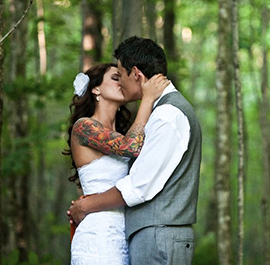 Most accomplished photographers, either serious amateurs or professionals, will say that the #1 reason beginners or casual photographers don’t shoot better pictures is because they are not close enough to their subjects. The message in the title of this PhotographyTalk article is that your best photos are in front of you if you would only move closer to the positions where you could take them.
Most accomplished photographers, either serious amateurs or professionals, will say that the #1 reason beginners or casual photographers don’t shoot better pictures is because they are not close enough to their subjects. The message in the title of this PhotographyTalk article is that your best photos are in front of you if you would only move closer to the positions where you could take them.
The most common example of this mistake is the vacation photo with family members or friends a great distance from the photographer, so he or she could include a lake, mountain range, buildings, monuments, etc. in the frame to identify where the picture was taken. The people in these types of pictures are so small, and often have deep shadows on their faces, that one wouldn’t know who they were without being told.
If this is what most of your vacation (and other) photos look like, then you’ve overlooked two opportunities to become a better photographer. Instead of shooting photos that include your family or friends and a wide view of the place you are visiting, photograph these two elements separately. Shoot one group of pictures of the architecture or natural wonders of your destination and another group that are much closer to family members and friends to show their reactions to where they are.
Nikon D600 | Nikon D7100 | Nikon D800 | Canon 5D Mark III | Canon EOS-1D X
Now you have an opportunity to learn and use techniques for architectural and/or landscape and nature photography as well techniques that make you a better people photographer. An additional benefit of this approach is that your photos will tell a much more interesting and compelling story of your visit or vacation than what you typically bring home.
All of these opportunities to improve your photography are available to you if you simply move closer to your subjects. When you don’t, it’s a signal that you’re not actually thinking about what you are shooting. You’ll never become a better photographer until you learn to pause, take a deep breath and use your brain to decide what kind of image you want to capture and how to achieve it. Maybe, the actual first step is stop being an unconscious photographer who is just pointing and shooting the camera.
To become a more thinking photographer, so you’ll find the best photographs in front of you, try these tips with a volunteer subject during an experimental shoot.
-
Leave your zoom lens at home
The telephoto focal lengths of a zoom lens will help you create better pictures of subjects because you can frame them tighter. Zoom lenses are particularly useful for street photography when you want to capture images of strangers. During your experimental shoot, however, limit yourself to one focal length, with a prime lens or locking your zoom lens. The prime is better, even if you must rent one, because you will be absolutely limited to its focal length. Shooting with a 35mm or 50mm lens will force you to move closer to your volunteer subject.
-
Subject interaction
Just because your vacation photos are of your mother, wife, children or close friends doesn’t preclude you from working with them like you would a model. Now that you’ve moved closer, give your subjects some detailed directions and not just “Stand closer and smile.” Don’t hesitate to try various poses. Instead of looking at the camera, ask them to look at the surrounding sights, which could evoke emotional reactions that become great storytelling images.
-
Crop in the camera
As part of your experiment, try your hand at cropping some of these closer photos of your subject in the camera instead of relying on editing software. There is no rule that states you must show the entire person or persons. Maybe a partial view of his or her face and an emphasized arm/hand gesture makes for a more powerful image. Think of showing only a part of a subject as he or she stands behind a larger object that identifies the location of your visit or vacation, such as building, sculpture, sign, monument, etc.
-
You can almost never be too close
Without belaboring the point, once you’ve finally unglued your shoes and moved closer to your volunteer subject, move closer yet for another group of images. Then, continue to move forward, taking more “test” shots. What you are likely to discover is that each distance from the subject provides new opportunities for great photos that are unique to that particular distance.
The simple technique of moving closer to your subject will broaden your photography horizons and do more to improve your pictures than almost any other technique you can learn and apply.
Also Read: 23 things you must know to be successful in photography
Recommended Reading:
- The Complete Photo Manual: 300+ Skills and Tips for Making Great Pictures
- Digital Photography: An Introduction
- Complete Digital Photography
- Photojojo!: Insanely Great Photo Projects and DIY Ideas
- Learn & Master Photography
- 110 Perfect Photography Tips for Beginners!
- 50 Photo Projects - Ideas to Kickstart Your Photography
People who read this PhotographyTalk.com article also liked:
Photo copyright PhotographyTalk member David Marshall
Your feedback is important to thousands of PhotographyTalk.com fans and us. If this article is helpful, then please click the Like and Re-Tweet buttons at the top left of this article.
